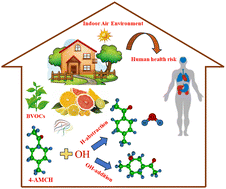Mechanistic and kinetic study of limona ketone oxidation initiated by hydroxyl radical: impact of indoor air pollution†
Abstract
Degradation of air quality in the atmosphere is mainly caused by air pollution and represents a major health risk. Limona ketone (LK) (C9H14O, 4-acetyl-1-methyl-1-cyclohexene) is emitted by α-pinene, which is massively present in the indoor environment and a major atmospheric source of secondary organic aerosols (SOAs), and has attracted attention in the field of atmospheric chemistry. The OH-addition and H-abstraction reactions of LK by OH radicals have been investigated using M06-2X, ωB97X-D, MP2 and CCSD(T) with the 6-311+G(d,p) basis set. Its degradation channels and reactions with O2, NO and HO2 radicals have been explored using quantum chemical methods. The reaction kinetics were studied theoretically over the temperature range of 278–350 K by employing canonical variational transition state theory with the small curvature tunnelling (CVT/SCT) method for both barrierless channels and channels with barriers. The addition of OH at the C1 position of LK at the endocyclic double bond was shown to be the most favourable, with a small relative energy barrier of −7.27 kcal mol−1, and H-abstraction at the C4 position exhibited a relative energy barrier of −1.65 kcal mol−1 at the M06-2X/6-311+G(d,p) level of theory. Our calculated energy results show that the OH addition reactions are more dominant than the H-abstraction channel through electronic rearrangement. The obtained overall rate coefficient at 298 K is 4.77 × 10−10 cm3 molecule−1 s−1, which is in good agreement with the experimental rate coefficient of kOH = (1.29 ± 0.33) × 10−10 at 296 ± 2 K and ∼735 Torr determined by Atkinson et al. Addition of the OH radical at the C1 position predominates over all the other reaction channels, with a branching ratio of 56.20% at 298 K. Our theoretical results suggest that the atmospheric lifetime is ∼0.58 hours and the formation of stable product 1-(hydroperoxy-4-methylcyclohex-3-en-1-yl) ethenone is thermodynamically exothermic in nature. This work provides valuable information regarding the degradation mechanism and atmospheric fate of LK in the reaction initiated by the OH radical.



 Please wait while we load your content...
Please wait while we load your content...